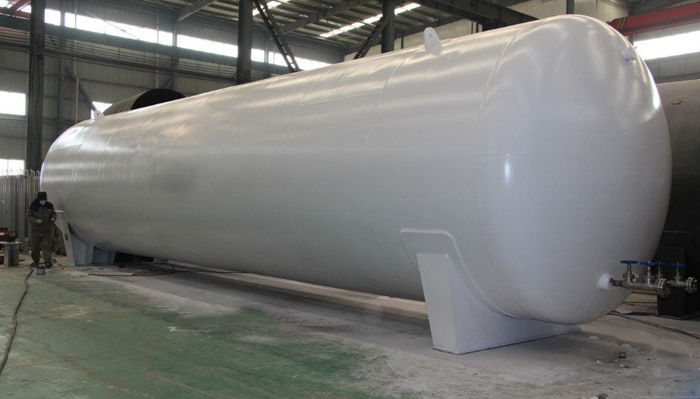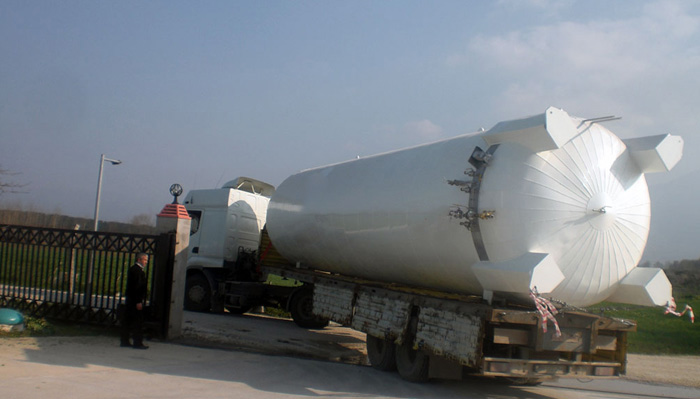Product Category
Factors of liquid nitrogen tank explosion
Date: Feb 17, 2020

The factors of liquid nitrogen tank explosion, the first is the external environmental impact.
1.High temperature and pressure
Liquid nitrogen is made by air compression cooling, and can be restored to nitrogen during gasification. Each liter of liquid is nitrogenized, the temperature rises by 15 ° C, and the volume expansion is about 180 times. Explosion occurs when the external temperature and pressure exceed the cooling temperature and pressure that the tank should withstand.
2. Collision vibration
The liquid nitrogen container tank has a special shock-proof design. In addition to standing storage, it can also be transported and used in a filled state. However, after the liquid nitrogen tank is severely impacted and shaken, the insulation layer or other components will be damaged, and the external environment will directly affect the gaseous materials and cause an explosion.
3. Poor ventilation through the seal
If the use of liquid nitrogen and poor ventilation in the storage environment will cause the indoor nitrogen and nitrogen monoxide gas content concentrations to accumulate and reach the explosion limit, which will cause an explosion.
The second factor is quality.
1. Improper selection of materials
Liquid nitrogen pressure vessel tanks are generally made of pure aluminum foil and stainless steel hot and cold rolled steel plates. If the specifications and quality of these main materials do not meet the requirements of the normative standards and cannot meet the conditions of refrigerated liquid nitrogen, explosions are likely to occur.
2. Poor insulation
The liquid nitrogen tank is composed of inner and outer bile tanks. The inner tank is surrounded by multiple layers of hot body. Once the reflective material and the heat insulation material fall off, it will cause adjacent reflective materials to directly contact the outer tank, which will rapidly expand the liquid nitrogen in the inner tank Vaporize until an explosion occurs. 3. Valves, meters and other accessories are outdated
3. Valves, meters and other accessories are outdated
In the long-term use process, if the valves, instruments and other accessories of the liquid nitrogen tank are not regularly inspected and replaced, once these accessories are old and aging, it will cause temperature rise or liquid nitrogen leakage and explosion.
The third is the human factor.
1. Improper storage and transportation
Liquid nitrogen tank storage types can generally be divided into storage tanks and transport tanks. The storage tank is mainly used for static storage of indoor liquid nitrogen, and it is not suitable for long-distance transportation under working conditions.
2. Improper use
For long-term use of liquid nitrogen tanks, if regular maintenance inspections and maintenance are not performed during the operation process, the equipment will have hidden dangers and may cause explosion accidents. When manipulating the liquid nitrogen tank, if the exhaust valve is not opened or opened to an insufficient degree, after a long period of natural evaporation of liquid nitrogen, the pressure of the inner cylinder rises. At this time, if there is no safety protection device and the pressure continues to rise, it may cause cracks at the bottom of the booster pipe to take over the original defect. Once liquid nitrogen leaks into the interlayer space and vaporizes, the interlayer pressure rapidly rises, which will cause the outer cylinder to explode. Some operators of liquid nitrogen tanks operate without safety education. They rely on the verbal instruction of the master to manipulate the skills. They have poor safety qualities and skills and are prone to accidents.
3.Liquid nitrogen leakage
The liquid nitrogen in the inner tank can not be discharged normally for a long time, or a large amount leaks into the interlayer space to vaporize, which may also cause the liquid nitrogen container to explode.
1.High temperature and pressure
Liquid nitrogen is made by air compression cooling, and can be restored to nitrogen during gasification. Each liter of liquid is nitrogenized, the temperature rises by 15 ° C, and the volume expansion is about 180 times. Explosion occurs when the external temperature and pressure exceed the cooling temperature and pressure that the tank should withstand.
2. Collision vibration
The liquid nitrogen container tank has a special shock-proof design. In addition to standing storage, it can also be transported and used in a filled state. However, after the liquid nitrogen tank is severely impacted and shaken, the insulation layer or other components will be damaged, and the external environment will directly affect the gaseous materials and cause an explosion.
3. Poor ventilation through the seal
If the use of liquid nitrogen and poor ventilation in the storage environment will cause the indoor nitrogen and nitrogen monoxide gas content concentrations to accumulate and reach the explosion limit, which will cause an explosion.
The second factor is quality.
1. Improper selection of materials
Liquid nitrogen pressure vessel tanks are generally made of pure aluminum foil and stainless steel hot and cold rolled steel plates. If the specifications and quality of these main materials do not meet the requirements of the normative standards and cannot meet the conditions of refrigerated liquid nitrogen, explosions are likely to occur.
2. Poor insulation
The liquid nitrogen tank is composed of inner and outer bile tanks. The inner tank is surrounded by multiple layers of hot body. Once the reflective material and the heat insulation material fall off, it will cause adjacent reflective materials to directly contact the outer tank, which will rapidly expand the liquid nitrogen in the inner tank Vaporize until an explosion occurs.

In the long-term use process, if the valves, instruments and other accessories of the liquid nitrogen tank are not regularly inspected and replaced, once these accessories are old and aging, it will cause temperature rise or liquid nitrogen leakage and explosion.
The third is the human factor.
1. Improper storage and transportation
Liquid nitrogen tank storage types can generally be divided into storage tanks and transport tanks. The storage tank is mainly used for static storage of indoor liquid nitrogen, and it is not suitable for long-distance transportation under working conditions.
2. Improper use
For long-term use of liquid nitrogen tanks, if regular maintenance inspections and maintenance are not performed during the operation process, the equipment will have hidden dangers and may cause explosion accidents. When manipulating the liquid nitrogen tank, if the exhaust valve is not opened or opened to an insufficient degree, after a long period of natural evaporation of liquid nitrogen, the pressure of the inner cylinder rises. At this time, if there is no safety protection device and the pressure continues to rise, it may cause cracks at the bottom of the booster pipe to take over the original defect. Once liquid nitrogen leaks into the interlayer space and vaporizes, the interlayer pressure rapidly rises, which will cause the outer cylinder to explode. Some operators of liquid nitrogen tanks operate without safety education. They rely on the verbal instruction of the master to manipulate the skills. They have poor safety qualities and skills and are prone to accidents.
3.Liquid nitrogen leakage
The liquid nitrogen in the inner tank can not be discharged normally for a long time, or a large amount leaks into the interlayer space to vaporize, which may also cause the liquid nitrogen container to explode.
Next article:
Send Your Inquiry
We not only provide a good product, but also provide high quality service. If you are interested in our products,
you can contact us in the following ways.
you can contact us in the following ways.















































































































